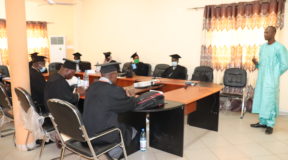On Thursday, March 28, 2019, from 14:05 to 3.30 pm in the classroom of 8m1, Dr. Mahamadou Saliou Diallo, learner of the 8m1 will present an article titled “Ebola RNA persistence in semen of Ebola virus disease survivor”.
Who is Dr Mahamadou Saliou DIALLO?
Learning from the 8M1 in public health, Dr. Diallo Mamadou Saliou holds a doctorate of State in medicine from the Faculty of medicine and odonto-stomamatology at the University of Conakry. Dr. Diallo is a research associate at the National Center for rural health training and research in Maferinyah Republic of Guinea since 2010, at the Center, he has held successively various functions namely (investigator, doctor, Clinical Coordinator of the research projects and principal co-investigator of the Ebola vaccine trial).
ABSTRACT
BACKGROUND
Ebola virus has been detected in the semen of men after their recovery from Ebolavirus disease (EVD). We report the presence of Ebola virus RNA in semen in a cohort of survivors of EVD in Sierra Leone.
METHODS
We enrolled a convenience sample of 220 adult male survivors of EVD in Sierra Leone,at various times after discharge from an Ebola treatment unit (ETU), in two phases (100 participants were in phase 1, and 120 in phase 2). Semen specimens obtained at baseline were tested by means of a quantitative reverse-transcriptase–polymerasechain-reaction (RT-PCR) assay with the use of the target sequences of NP and VP40 (in phase 1) or NP and GP (in phase 2). This study did not evaluate directly the risk of sexual transmission of EVD.
RESULTS
Of 210 participants who provided an initial semen specimen for analysis, 57 (27%) hadpositive results on quantitative RT-PCR. Ebola virus RNA was detected in the semen of all 7 men with a specimen obtained within 3 months after ETU discharge, in 26 of 42 (62%) with a specimen obtained at 4 to 6 months, in 15 of 60 (25%) with a specimen obtained at 7 to 9 months, in 4 of 26 (15%) with a specimen obtained at 10 to 12 months, in 4 of 38 (11%) with a specimen obtained at 13 to 15 months, in 1 of 25 (4%) with a specimen obtained at 16 to 18 months, and in no men with a specimen obtained at 19 months or later. Among the 46 participants with a positive result in phase 1, the median baseline cycle-threshold values (higher values indicate lower RNA values) for the NP and VP40 targets were lower within 3 months after ETU discharge (32.4 and 31.3, respectively; in 7 men) than at 4 to 6 months (34.3 and 33.1; in 25), at 7 to 9 months (37.4 and 36.6; in 13), and at 10 to 12 months (37.7 and 36.9; in 1). In phase 2, a total of 11 participants had positive results for NP and GP targets (samples obtained at 4.1 to 15.7 months after ETU discharge); cycle-threshold values ranged from 32.7 to 38.0 for NP and from 31.1 to 37.7 for GP.
CONCLUSIONS
These data showed the long-term presence of Ebola virus RNA in semen and decliningpersistence with increasing time after ETU discharge. (Funded by the World Health Organization and others.)









